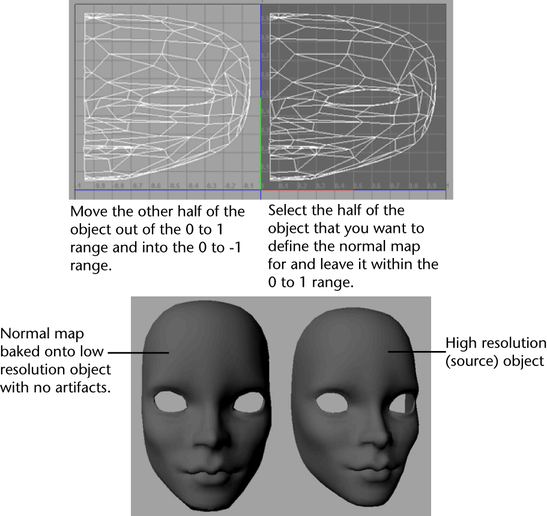Show in Contents

Add to Favorites

Home: Autodesk Maya Online Help

Viewing tangent space or object space normal maps

Map and position textures

Hardware shading limitations

Creating and using mirrored
normal maps on a character or object
Mirroring a normal map
across a character allows you to optimize texture usage where all
of the normal map detail is symmetric around the UV axis. For example,
the two arms of your character may share the same normal map.
If both halves of the
geometry are rendered into the normal map on top of each other,
the mirroring of the normals introduces artifacts into the combined
result. Therefore, you need to specify which half of the geometry defines
the normal map (and which half just uses it).
Follow these steps to
create your normal map.
Creating and displaying a mirrored normal
map on a character or object: Option 1
- Set the UV Winding Order of
your object to Detect to ensure that both sides
of your mirrored normal map are displayed correctly. For more information
about UV Winding Order, see
UV Winding Order in
the Polygonal Modeling guide.
- Select the half of the object (for example,
face) that you want to define the normal map for. Leave this half
within the 0 to 1 UV range.
- Move the other half of the object out
of the 0 to 1 UV range so that it does not affect the generated
normal map.
- Bake the normal map using
Lighting/Shading > Transfer Maps.
Creating and displaying a mirrored normal
map on a character or object: Option 2
- Set the UV Winding Order of
your object to Detect to ensure that both sides
of your mirrored normal map are displayed correctly. For more information
about UV Winding Order, see
UV Winding Order in
the Polygonal Modeling guide.
- Select
Lighting/Shading > Transfer Maps and
enable the Ignore Mirrored Faces option
under the Maya Common Output section.
See
Ignore Mirrored Faces for
more information.
Tip
- For best results, ensure that each side
of your model has consistent UV winding. Otherwise, artifacts may
appear.
- To avoid seams when mirroring normal
maps on a character, ensure that the source geometry is symmetric.
That is, one side of the character matches the other. This becomes
particularly important when working with surface meshes that are
derived from scan data.

